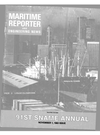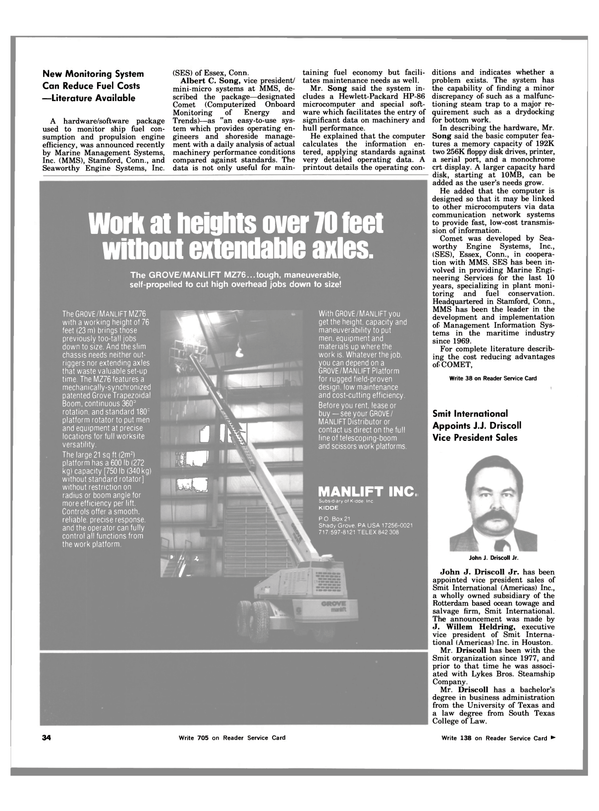
TCS Cuts Barge-Moving Costs With New Winch-Control System
Bulk-carrying river barges often look as if they are floating effortlessly upon the waters, but St.
Paul, Minn.-based TCS Industrial knows that it takes a lot of power to handle one. Therefore, specially designed barge-moving systems are a must for any terminal dock.
TCS Industrial's solution to this load-handling problem has been to use two side-by-side winches powered by an electro-hydraulic power unit feeding low-speed, high-torque motors. Wire rope runs from each winch to a connecting link which is secured to the barge to control its movement. It is reaved around various sheaves to form a continuous loop arrangement, which allows its end to return to the second winch situated next to the first one. Proper tension is applied to the lines to hold the barge in its selected position and, when it must be moved forward or backward under the loading spout, the proper winch is activated to move it in the right direction. As one winch takes in line the other pays it out.
The system works well, with two notable exceptions. Cavitation takes place when the oil is subjected to a vacuum at the inlet of the motor (which is at the time acting as a pump), and vaporizes.
Also, the band-type brakes cause problems. Every time it rained the open bands would swell up and become tight, requiring an employee to be constantly on hand to adjust them. The brakes' actuating cylinders also often leaked.
Searching for a solution, TCS Industrial engineers worked with applications engineers at the local J.N. Fauver Company office. This team analyzed the problem and realized it had two basic options.
One was to build a hydraulic bypass into the system so the motor would not starve or cavitate. This solution has since been retrofitted on units already in the field.
The other option, the one selected for the new system, was to hydraulically disengage the unused motor from the circuit with an Ausco hydraulic clutch. This new design also used a totally enclosed Ausco failsafe brake, which completely eliminates both the adjustment and leaking problem previously encountered when using open-type brakes.
Each of the two winches now includes an overhung load adapter, with the Ausco failsafe brake piggybacked to it. Next comes the clutch and then the motor. Using direct-spline shafts and matched SAE mountings, it really becomes an integral drive train that eliminates the problems previously experienced.
The failsafe brakes are spring applied and hydraulically released.
When hydraulic pressure is applied to a motor through a shuttle valve, the pressure also goes to the brake cylinder and releases the brake discs. When pressure is released the built-in springs automatically re-apply the brake.
The units are completely enclosed, which precludes water from affecting their performance.
The advantages of the system are obvious. Each of the two winches has its own drive train.
To move a barge the operator activates a hand-held, electrical-proportional hydraulic control valve, which releases both brakes so one cable can pay out while the other is being wound on a drum. As the control valve releases the brakes it also starts to direct oil through the hydraulic motors. As they turn, the exiting oil flows over a load control which creates a back pressure signal that is read by the clutch in the winch system that is taking in the line, and it actuates to turn the winch. But the other clutch does not receive such a signal so its hydraulic motor does not turn backwards. Because it is "declutched" the motor rests as the line pays out.
These new changes have solved the problems previously encountered.
The heart of the system is the electro-hydraulic power unit situated at any convenient location at the terminal. In addition to barge moving, the hydraulic circuitry may be configured to provide power for other requirements, such as spout handling or cover pulling. Proportional controls allow a variable-speed movement between 0 to 50 fpm, moving up to four barges at one time. The system provides an efficient and positive method of moving empty or loaded barges between mooring points at a dock, terminal or other marine facilities, whether the duty cycle is continuous or the frequency of movement is intermittent, with local or remote (or both) radio or pendant variable-speed control.
For complete details on the new barge moving system, Write 12 on Reader Service Card
Read TCS Cuts Barge-Moving Costs With New Winch-Control System in Pdf, Flash or Html5 edition of November 1983 Maritime Reporter
Other stories from November 1983 issue
Content
- Indonesia Signs $150-Million Agreement For 4 Boeing Jetfoils page: 5
- Joint Venture Formed By Union Carbide And MTL page: 5
- Marine Consultants To Conduct Study For MarAd On Bulk Carriers page: 6
- Glomar Robert F. Bauer Christened At FELS page: 6
- Global Marine Introduces New Designs For New Generation Of Heavy Weather Jackups page: 6
- McDermott Pla ns Study Of Fixed Platforms For 1,600-Foot Water Depths page: 7
- M i t c h e l l M a r i n e Delivers Fourth Service Boat page: 7
- North Sea Maureen Field Commences Oil Production page: 8
- Swift Group Management Promotions Announced page: 8
- Bay Shipbuilding Building Coal Topping Off Barge page: 8
- Radm. Nunneley New President Of ASNE page: 9
- Ship Survivability Topic Of Symposium In Philadelphia December 7 page: 10
- Miniliner Newport Clipper Delivered By Jeffboat page: 10
- Marinette Marine Awarded $6-Million Navy Contract page: 11
- ASNE Call For Papers For '84 Naval Ship Symposium page: 11
- Third ARS Keel Laying At Peterson Builders page: 12
- Navy Awards Tracor $7.7-Million Contract page: 12
- Thomas Marine Offers 38' Aluminum Crewboat —Literature Available page: 12
- Free Mobil Literature Details New Diesel Oil For High Output Engines page: 13
- Nav-Com Names Franza Director Of Marketing page: 13
- Nichols To Build New Seattle Fireboat page: 14
- Offshore Drilling Rig Sedco 602 Delivered By Promet Shipyard page: 14
- Uniroyal Fendering To Be Fitted On ARAMCO Tug —Literature Available page: 14
- Farrell Lines To Test U.S. Sea Shed System's Commercial Applications page: 15
- CSSRA 1984 Technical Conference Set For February 14 In Montreal page: 16
- McDermott To Build $6-Million Matson Container Barge page: 16
- Changes In The Navy Shipbuilding Program — An Update — page: 16
- New 8-Page Brochure On Micro = Lam Scaffold Planks Offered Free By Trus Joist page: 17
- New Updated Edition Of "American Harbour Pilot" By Hans Gade Is Available page: 18
- CRC Welding Systems Moves To Houston page: 18
- ACR Projects Business Improvement For 1984 page: 19
- Ogden Corporation Announces Spinoff Of Ogden Marine Inc. page: 19
- Rail Deregulation, User Taxes Threaten Barge And Towing Industry page: 20
- Icebreaker Contract For Halifax Shipyard Totals Can. $54 Million page: 21
- AMP Introduces New Line Of Ribbed Wire Splices —Literature Available page: 21
- Dock Express Changes Management Structure page: 24
- RMI Adds Four Members To Board Of Directors page: 25
- Wartsila Diesels To Power Sonat Semisubmersible —Literature Available page: 25
- The Marine Board Of The National Research Council Plans November Symposium page: 26
- Blount Marine Gets Orders For Three New Vessels page: 26
- PIMA Established As Shipbuilding/Repair Agents page: 26
- Navy Saves $22 Million In Three Months With Competitive Bidding Plan page: 27
- Butterworth Names Smith Tank Cleaning Machine Product Line Coordinator page: 27
- U.S. And Canadian Companies Licensed To Build Vickdock page: 27
- Rice Named Director of AMB Barge Train page: 29
- Halter-Built Paddlewheeler Is First Exhibit Completed For 1984 Louisiana World's Fair page: 30
- OFFSHORE RESURGENCE BEGINS page: 32
- N.Y. Port Engineers Society Discusses Importance Of Propeller Finish page: 33
- N e w M o n i t o r i n g System Can Reduce Fuel Costs — L i t e r a t u r e A v a i l a b le page: 34
- Halter Marine Completes Contract With Tidewater page: 34
- Great Lakes Towing Christens 250-Ton Drydock page: 35
- TCS Cuts Barge-Moving Costs With New Winch-Control System page: 36
- Financial Moratorium At Verolme Botlek Lifted page: 37
- Concrete Offshore Platform Designed By Foundation-Skanska page: 37
- Productivity Advances In Shipbuilding page: 38
- National Marine Names Mangan Service Manager page: 40
- Fetterolf Acquires Stacey Valve Products —Literature Available page: 40
- Mitsui Delivers The Kepbreeze page: 45
- SNAME Gulf Section Meets In Biloxi page: 45
- Armco Adds Forging Capability For Stainless-Steel Products —Free Literature Available page: 45
- Submarine Honolulu Launched At Newport News Shipbuilding page: 45
- The New Boston Shipyard Begins Operations page: 46
- A New Concept In Chemical Barge Transportation page: 47
- MARCO Pacific To Build New Design Tuna Purse Seiner page: 47
- Free 200-Page Book Describes The Corrosion Resistance Of Zinc page: 48
- $140-Million Contract To Daewoo Shipbuilding page: 48
- ASTM Standards Committee On Shipbuilding To Meet In Seattle In November page: 49
- Wartsila Opens Newest Factory In Singapore —Engine Literature Available page: 50
- 91st S N A ME Annual Meeting Second International Maritime Exposition page: 54
- Power Factor Savings W i th Energy Efficient M o t o rs page: 86
- B u r r a r d Y a r r o w s To B u i l d T w o I c e b r e a k e rs For Can. $ 1 0 8 . 5 - M i l l i on page: 86
- M o r m a c Ship Saves Fuel W i t h Westinghouse C o n t r o l System — L i t e r a t u r e A v a i l a b le page: 88
- Maritime Satellites Now Reach 2,000 Users page: 89
- Electro-Nav Brochure Describes Microprocessor Controlled Marine Receiver page: 89
- Innovative "Flexor" Barge Connector Allows Blue Water Barge Trains page: 90
- Bay Shipbuilding Converts Ex-President Harrison page: 90
- Caterpillar Offers Free Literature On New Lift Truck For Containers page: 92
- Squire-Cogswell Offers Literature On Oil-Free Marine Air Compressors page: 92
- $250,000 Order For Atlas Fishing Systems —Literature Available page: 95
- Fire-Tested Valves And Actuators Described In Free Jamesbury Brochure page: 97
- Port Allen Marine Offers Four-Color Brochure On Full Shipyard Services page: 98
- Free 4-Color Howe Baker Brochure Shows How New Burner Cuts Fuel Costs page: 100
- Magnus Maritec Completes $2 Million Expansion Of Fuel Oil Testing Service —Literature Available page: 101
- Navy Lets $8.3-Million Contract To Tracor page: 102
- Moss Point Building Five Other Vessels For Joint Venture page: 104
- Hoffman Maritime Names Finn C. Michelsen Technical Director page: 106
- Economic Benefit Of FY 84 Navy Construction Program Outlined By Shipbuilders Council page: 108
- Northern New England ASNE Announces 83-84 Program page: 109
- GM Increases Diesel Power Ratings And Offers New Applications Manual page: 110
- N e w L i t e r a t u r e Describes T h o r d o n Shaft Bearings For D i r t y W a t e r O p e r a t i on page: 111
- Maritime Prepositioning Conversions Begin At Bethlehem's Beaumont Yard page: 112
- Split-Hull Hopper Dredge Delivered By Nichols page: 117
- SNAME Metropolitan Section Reviews T-AKX Ship Conversion page: 118
- Halter Marine Completes Four-Boat Contract For Zapata Marine page: 118
- Captain Grabb Appointed ASNE Technical Director page: 120
- Free Literature Available On Marconi's New ARPA page: 122
- Cousteau Begins River D o c u m e n t a r y ; Biehl And Company Named Agent page: 129


